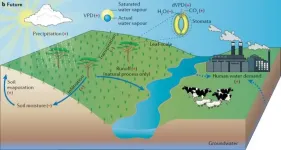Toward a more comprehensive understanding of aridity changes over global drylands
2021-03-16
(Press-News.org) Global drylands are experiencing faster-than-average warming and are also among the most vulnerable regions to climate change. Meteorological metrics all point to an emerging trend of increased surface aridity, raising concerns of land desertification and degradation. However, recent satellite observations also show lusher drylands, in apparent contradiction to the image of drylands becoming drier. In a new Review Article published in Nature Reviews Earth & Environment, an international team comprehensively examined global dryland aridity changes with evidence from the literature and various sources of Earth observations and numerical modeling. A key message of this synthesis is that, by considering the physiological effect of rising atmospheric carbon dioxide (CO2), the apparent paradox between enhanced surface aridity and lusher dryland vegetation can actually be resolved.
Led by researchers from Peking University, the team includes scientists with diverse expertise on global dryland research from China, UK, France, Australia, USA and Austria. By employing a broad range of aridity metrics, the team provided a more complete picture of current and future aridity changes over global drylands. They found that atmospheric-based metrics generally show a strong trend of rising dryness; while soil moisture and runoff also imply increasing dryland aridity, yet at slower paces. By contrast, ecosystem-based metrics show a trend of greening and reduced plant water stress, despite the rising atmospheric dryness. The co-occurrence of atmospheric drying and ecosystem greening over drylands is also confirmed by model simulations of vegetation dynamics.
Lian Xu from Peking University, the lead author of this study, explains: "Literally, aridity means insufficient water supply to meet the demand. However, for different parts of the land surface, their supply and demand sides are different; and they can move in divergent directions under environmental change. Therefore, when different dryness metrics are brought together in a unified framework, they can have very different trends". He further added: "No single metric fully captures the complex nature of the land surface aridity".
Higher temperatures increase atmospheric demand for water, and are expected to aggravate plant water stress. However, dryland plants are found to experience reduced levels of water stress thanks to the simultaneously increasing concentration of atmospheric CO2. This is because the pores of plant leaves (stomata), which allow for water loss through a process called transpiration, partially close under higher CO2 concentrations, conserves water under increasing aridity. For water-stressed ecosystems, the saved water allows plants to capture extra CO2 and thus trigger more vigorous growth (greening). The reduced plant transpiration also impacts other land surface processes, leaving more water stored in soils and running off through rivers, but at the same time also making the near-surface air warmer and drier.
"It is always tempting to define the water stress plants will feel under climate change by the new weather regimes they might experience. Our research shows that ignoring vegetation physiological response gives an incomplete picture, as the capability to adjust to drier conditions is stronger than expected", said Chris Huntingford from the UK Centre for Ecology and Hydrology.
The authors note that future changes to drylands may be highly nonlinear, and subject to additional drivers such as flash droughts, fire disturbances and intensification of human activities, which are not yet fully understood. "Understanding possible nonlinear behaviors and tipping points of dryland ecosystem changes, and improving their representation in Earth system models, is a high priority for future research", Lian added.
In the future, the rapidly growing populations and socio-economic development in drylands may increase human water demand dramatically, which will become the key driving force of dryland aridity changes, competing with ecosystems for water and posing a growing threat to ecosystem health. "Dryland water-resource management and climate-change mitigation policies should consider how to manage water in more efficient and sustainable ways, to safeguard food security while simultaneously maintain healthy ecosystems", said Fu Bojie of the Chinese Academy of Sciences, who leads the Global Dryland Ecosystem Programme (Global-DEP) aiming to facilitate dryland social-ecological sustainability.
INFORMATION:
Full paper reference: Lian, X. et al. Multifaceted characteristics of dryland aridity changes in a warming world. Nature Reviews Earth & Environment (2021).
https://www.nature.com/articles/s43017-021-00144-0.
[Attachments] See images for this press release:

ELSE PRESS RELEASES FROM THIS DATE:
2021-03-16
New findings on the diet of Arctic foxes, determined by the condition of their teeth, show how varying climate conditions in the Arctic affect the animals that live there.
In a study published in Polar Biology, Peter Ungar, Distinguished Professor of anthropology at the University of Arkansas, and several co-authors analyzed tooth breakage and wear - both gross and micro - of Arctic foxes from Russia's Yamal Peninsula.
Studying the effect of varying climate conditions within this region helps scientists understand the impact of climate change on ...
2021-03-16
When it comes to electric vehicles, particularly for heavy-duty trucks, the limitations of battery technology are often seen as the main barrier to widespread adoption. However, a new analysis concludes that it's the lack of appropriate policies around adoption incentives, charging infrastructure, and electricity pricing that prevents widespread electrification of commercial trucking fleets.
Researchers from the Department of Energy's Lawrence Berkeley National Laboratory (Berkeley Lab) and the University of California, Los Angeles published a new study that makes the case for prioritizing public policy to help move long-haul trucking from diesel to electric. Doing so will mean huge gains in addressing the ...
2021-03-16
Kanazawa, Japan -- Any visitor to China will have noticed the spectacular roofs on buildings dating from imperial times. However, the question of how these roof tiles were produced has attracted relatively little attention from archaeologists. Now, a team of researchers has conducted a major study of tile ends unearthed at the Ximing Temple in Xi'an, yielding exciting insights into their production.
In a study published in Archaeological Research in Asia, researchers from Kanazawa University and the Chinese Academy of Social Sciences have revealed the significance of minute variations in the tile ends used in the roof of the famous Ximing Temple in Xi'an, built during the ...
2021-03-16
Researchers from Tokyo Medical and Dental University (TMDU) identify a novel mechanism underlying hair thinning and loss during aging
Tokyo, Japan - Hair grows from stem cells residing in hair follicles. During aging, the capability of hair follicles to grow hair is successively lost, leading to hair thinning and ultimately hair loss. In a new study, researchers from Tokyo Medical and Dental University (TMDU) and the University of Tokyo identified a novel mechanism by which hair follicles lose their regenerative capabilities.
Hair follicles are mini-organs from which new hair constantly grows. The basis for new hair growth is the proper function of hair follicle stem cells (HFSCs). HFSCs undergo cyclic symmetric and asymmetric cell divisions ...
2021-03-16
A genetic defect could hold the key to preventing or delaying the onset of a debilitating eye disease that can lead to vision loss and blindness.
MacTel (macular telangiectasia type 2) affects one in 1,000 Australians. Symptoms include slow loss of vision, distorted vision and trouble reading. Because early signs of the disorder are subtle, it is difficult to diagnose.
Researchers have identified an additional seven regions in the human genome that increase the risk of developing the condition, including a rare DNA mutation in the PHGDH gene, which will help clinicians to better diagnose and treat ...
2021-03-16
Nanograined metals and alloys, whose grain size is less than 100 nm, exhibit extremely high strength and high ductility, possessing excellent mechanical properties. Nanograined materials, however, have a large number of grain boundaries and hence high total grain boundary energy. At a temperature higher than a critical temperature, grains in nanograined materials will grow spontaneously to reduce the grain boundary energy, leading to thermal instability of the materials. A common approach to enhance the thermal stability is via grain boundary energy segregation, which thermodynamically lowers the grain boundary energy and kinetically pins ...
2021-03-16
An inter-disciplinary team of researchers led by Prof. Qian Peiyuan, Chair Professor at the Hong Kong University of Science and Technology (HKUST)'s Department of Ocean Science and Division of Life Science has unraveled how a novel microbial small molecule released by Streptococcus mutans (S. mutans) - a bacterium commonly found in the human oral cavity - is connected to dental caries development using a synthetic biology approach, offering new insights to the health impact of the human oral microbiota and facilitating future research on the prevention of tooth decay. The research findings were recently published in the prestigious scientific journal Nature Chemical Biology and reported by Nature as one of the research highlights.
Every wetted surface on our ...
2021-03-16
The Three Gorges project, completed in 2009, is one of the world's largest hydropower projects. It has brought important social and economic benefits in flood control, power generation, shipping and water resources redistribution.
But how does such a large-scale water conservancy project affect the local climate, and is the response to climate change a relatively vulnerable one? The Three Gorges Project has been repeated questioned, especially whenever rainstorms, floods and drought hit the area around the reservoir area or its neighboring areas, since ...
2021-03-16
Following a relocation of ice cores to the Copenhagen suburb of Rødovre in 2017, University of Copenhagen researchers found unopened boxes of ice cores dating back to 1966--the first ice cores drilled on Earth.
Analyses of the long-forgotten ice have now been completed and are presented in a new study with groundbreaking results.
Within the cores, which come from deep within the ice sheet at Camp Century, Greenland, the UCPH researchers and their Belgian and American colleagues became the first ever to find these millions of years old macrofossils.
The fossils are large enough to be seen without a microscope.
"We pinched ourselves over the treasure we'd found! Because within the cores, ...
2021-03-16
Sugar is added to many common foodstuffs, and people in Switzerland consume more than 100 grams of it every day. The high calorie content of sugar causes excessive weight and obesity, and the associated diseases. But does too much sugar have any other harmful effects if consumed regularly? And if so, which sugars in particular?
Even moderate amounts of sugar increase fat synthesis
Researchers at the University of Zurich (UZH) and the University Hospital Zurich (USZ) have been investigating these questions. Compared to previous studies, which mainly examined the consumption ...
LAST 30 PRESS RELEASES:
[Press-News.org] Toward a more comprehensive understanding of aridity changes over global drylands






